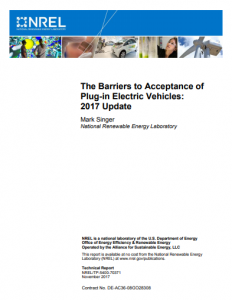Full Title: The Barriers to Acceptance of Plug-in Electric Vehicles: 2017 Update
Author(s): Mark Singer
Publisher(s): National Renewable Energy Laboratory
Publication Date: November 1, 2017
Full Text: Download Resource
Description (excerpt):
This report details American public sentiments toward issues surrounding plug-in electric
vehicles (PEVs) and is supported by the U.S. Department of Energy’s Vehicle Technologies
Office in alignment with its mission to research and implement these technologies to improve
energy security, enhance mobility flexibility, reduce transportation costs, and increase
environmental sustainability.
A PEV is broadly defined as a vehicle that can be plugged in, is powered by an electric motor,
and uses energy stored in an onboard battery. The definition encompasses all-electric vehicles
(AEVs) that are powered by electric motors only and plug-in hybrid electric vehicles (PHEVs)
that can also be powered by an internal combustion engine (ICE) fueled by petroleum fuel. The
most recent generation of PEVs has been commercially available in the United States since
December 2010. A PEV is different from a hybrid electric vehicle (HEV). An HEV is similar to
a PHEV, as it is powered by an ICE and an electric motor that uses energy stored in a battery.
However, the battery in an HEV cannot be plugged in; it is completely charged by fuel used in
the ICE, either through a generator, or indirectly through regenerative braking.
Understanding consumer sentiments can influence the prioritization of implementation efforts by
identifying barriers to, and opportunities for, the broad acceptance of new technologies. The data
detailed in this report represents three years of annual studies completed to track public
perceptions associated with PEV implementation efforts. This report is intended to support the
evaluation of whether advancing vehicle technologies and changing vehicle availability align
with evolving consumer expectations and interests over time.
